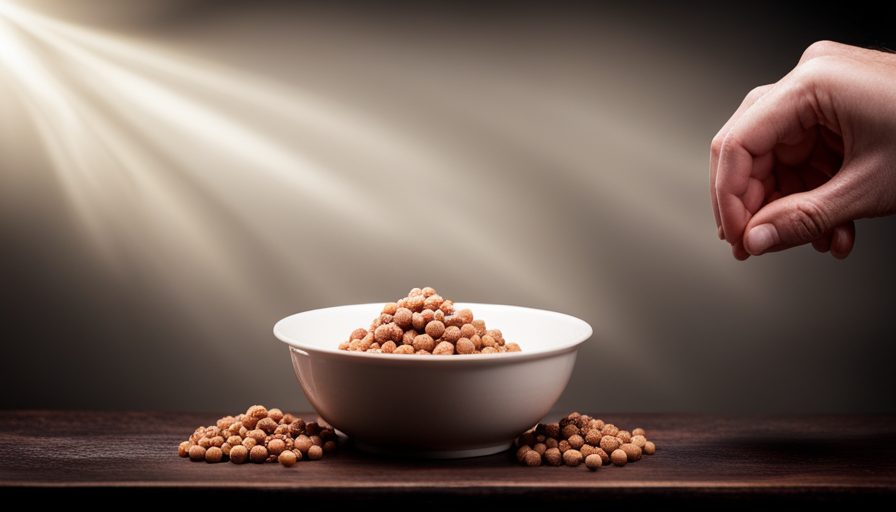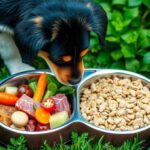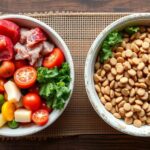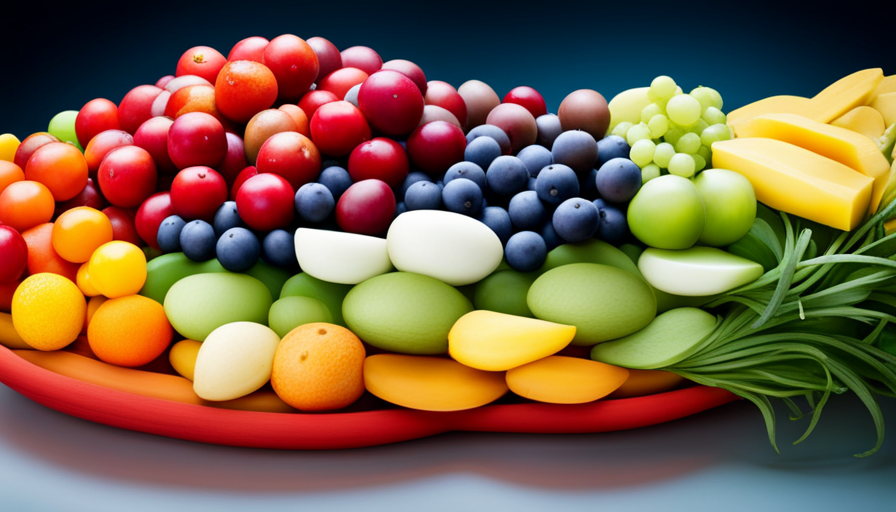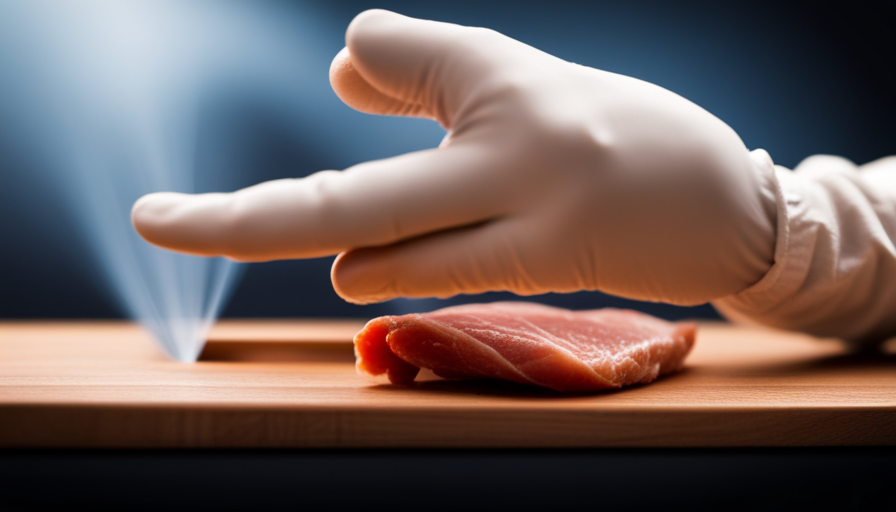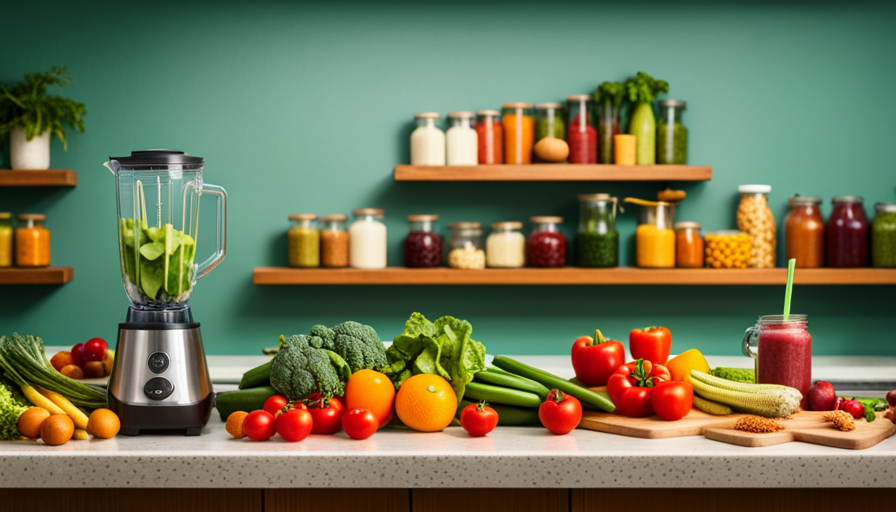Are you ready to enhance your pet’s nutritional care?
Imagine a diet that is not only delicious and satisfying, but also supports their overall health and vitality. Feeding your furry friend a combination of frozen raw food and kibble can provide just that! With this powerful duo, you can unlock a whole new world of benefits for your pet.
In this informative guide, we will delve into the art of feeding frozen raw food with kibble, exploring the many advantages it offers. From enhanced nutrient absorption to improved digestion and dental health, this mixed diet can revolutionize your pet’s wellbeing.
But how do you navigate this dietary journey? Don’t worry, we’ve got you covered. We’ll walk you through the process step by step, from selecting the highest quality raw food and kibble to transitioning your pet seamlessly. Plus, we’ll address common concerns and challenges along the way, ensuring a smooth and successful feeding experience.
Get ready to unleash the power of a mixed diet for your furry companion!
Key Takeaways
- Feeding a combination of frozen raw food and kibble provides a balanced diet with enzymes, probiotics, and a variety of textures and flavors.
- Select high-quality raw food brands to ensure a balanced and nutritious meal for pets.
- Gradually transition pets to a mixed diet to minimize digestive upset, and consult with a veterinarian for the ideal ratio and transition plan.
- Proper storage and handling of frozen raw food is crucial to prevent bacterial contamination, so thaw it in the refrigerator and store it separately from kibble to prevent cross-contamination.
Understanding the Benefits of a Mixed Diet
You’re probably wondering why combining frozen raw food with kibble can be so beneficial for your furry friend. Well, let’s start by understanding the risks associated with a single diet.
Feeding your pet only kibble can lead to nutritional deficiencies and health issues in the long run. While kibble provides convenience and balanced nutrition, it often lacks the necessary enzymes and nutrients found in raw food. This is where the concept of a mixed diet comes in.
Contrary to some myths, blending frozen raw food with kibble has numerous advantages. Firstly, it ensures that your pet receives a wide range of nutrients from different sources. Raw food contains natural enzymes and probiotics that aid in digestion and boost the immune system. Combining it with kibble ensures a balanced diet that meets your pet’s nutritional needs.
Secondly, the combination provides a variety of textures, flavors, and smells that can enhance your pet’s mealtime experience. This can be especially beneficial for picky eaters or pets with reduced appetites.
By incorporating frozen raw food with kibble, you provide your furry friend with the best of both worlds. It addresses the potential risks of a single diet while debunking the myths surrounding a mixed diet. Remember, always consult with your veterinarian to determine the ideal ratio and transition plan for your pet’s specific needs.
Choosing High-Quality Raw Food and Kibble
When it comes to nourishing your pet, selecting top-notch options for both frozen raw meals and kibble is paramount. Choosing high-quality raw food brands is essential for providing your pet with a balanced and nutritious diet. Look for brands that use human-grade ingredients, are sourced responsibly, and go through rigorous testing to ensure safety.
Feeding raw food and kibble together offers numerous benefits for your pet. Raw food provides the natural enzymes, vitamins, and minerals that are often lost during the cooking process of kibble. It also promotes healthy digestion and can improve your pet’s coat, skin, and overall vitality. Kibble, on the other hand, provides the convenience and affordability that raw food may lack. It contains essential nutrients and can help maintain good dental health.
When combining frozen raw food and kibble, it’s important to follow the appropriate ratios recommended by your veterinarian or a pet nutritionist. This will ensure that your pet receives the right balance of nutrients from both sources. Gradually introduce the raw food into your pet’s diet to allow for an adjustment period.
By choosing high-quality raw food brands and incorporating them with kibble, you can provide your pet with a well-rounded diet that meets their nutritional needs. Remember to consult with your veterinarian to determine the best approach for your pet’s specific dietary requirements.
Transitioning Your Pet to a Mixed Diet
Introducing a varied diet can be an exciting and beneficial journey for your furry companion, ensuring they experience a range of flavors and textures to tantalize their taste buds and keep them happy and healthy. When transitioning your pet to a mixed diet of frozen raw food and kibble, it’s important to follow a gradual transitioning process to minimize any potential risks.
The transitioning process involves slowly introducing the new food while gradually reducing the old food over a period of 7-10 days. This allows your pet’s digestive system to adapt to the change and reduces the chances of digestive upset. Start by mixing a small amount of the frozen raw food with the kibble and gradually increase the proportion of raw food each day.
To help you visualize the transitioning process, here’s a table representing a sample 7-day transition plan:
| Day | Kibble (%) | Frozen Raw Food (%) |
|---|---|---|
| Day 1 | 75 | 25 |
| Day 2 | 50 | 50 |
| Day 3 | 25 | 75 |
| Day 4+ | 0 | 100 |
It’s important to monitor your pet’s response to the new diet during the transition period. Look out for any signs of gastrointestinal upset, such as diarrhea or vomiting. If you notice any adverse effects, slow down the transition process or consult with your veterinarian for guidance.
By following a gradual transitioning process and monitoring your pet’s response, you can successfully introduce a mixed diet of frozen raw food and kibble, providing them with a balanced and nutritious meal while minimizing potential risks.
Properly Storing and Handling Frozen Raw Food
Don’t underestimate the importance of proper storage and handling to ensure your furry friend’s frozen feast stays fresh and safe. When it comes to feeding frozen raw food with kibble, it’s crucial to follow the right steps to prevent any potential risks associated with bacteria growth and cross-contamination.
Here’s how you can properly thaw and handle frozen raw food to keep your pet healthy and happy:
-
Thawing: Thaw the frozen raw food in the refrigerator to maintain a safe temperature and minimize bacterial growth. Avoid thawing at room temperature or using a microwave, as these methods can lead to uneven thawing and increase the risk of bacterial contamination.
-
Separate Storage: Store the frozen raw food separately from kibble to prevent cross-contamination. Bacteria from raw food can easily transfer to kibble if stored together, posing a risk to your pet’s health. Use separate containers or bags for each type of food.
-
Clean Surfaces: Always clean and sanitize the surfaces, utensils, and bowls used for handling raw food. This step helps eliminate any potential bacteria that could contaminate the food and cause illness.
-
Proper Portions: Thaw and serve only the amount of frozen raw food that your pet will consume in one meal. This prevents wastage and reduces the risk of bacterial growth if any leftovers are not handled properly.
By following these guidelines, you can ensure that your pet’s frozen raw food is properly thawed and handled, minimizing the risk of bacterial contamination and cross-contamination with kibble. Your furry friend will enjoy a safe and nutritious meal every time.
Balancing Nutritional Needs
To ensure your furry friend’s diet is well-rounded and meets all their nutritional needs, it’s important to find the perfect balance between different types of nourishing meals. When feeding frozen raw food with kibble, it’s crucial to consider the nutritional composition of both types of food and make adjustments accordingly.
Balancing nutrients is essential to prevent any potential deficiencies or imbalances in your pet’s diet. Frozen raw food typically consists of raw meat, bone, and organs, which provide essential nutrients such as protein, fat, vitamins, and minerals. On the other hand, kibble is a processed form of food that’s often fortified with additional vitamins and minerals. By combining these two types of food, you can ensure that your pet receives a wide range of nutrients.
However, it’s important to be aware of the potential risks associated with feeding frozen raw food and kibble together. Some concerns include the risk of bacterial contamination from raw food and the potential for digestive upset when switching between different types of food. It’s crucial to handle and store frozen raw food properly and follow safe food handling practices to minimize these risks.
Balancing nutritional needs when feeding frozen raw food with kibble is essential for your pet’s overall health and well-being. By carefully considering the nutritional composition of both types of food and being aware of the potential risks, you can provide a well-rounded and nourishing diet for your furry friend.
Adjusting Portion Sizes for a Mixed Diet
You might think that adjusting the portion sizes for a mixed diet is as simple as a walk in the park, but it’s more like navigating a maze blindfolded. When it comes to feeding a combination of frozen raw food and kibble, finding the right balance can be tricky.
Adjusting portion sizes is crucial to ensure that your pet receives the proper nutrition from both types of food.
One mealtime strategy is to divide the daily recommended portion into two meals, one with frozen raw food and the other with kibble. This allows for a more gradual transition and helps prevent digestive upset. Start by serving half of the recommended portion of each type of food and monitor your pet’s weight and overall condition. Adjust the portion sizes accordingly to maintain a healthy weight.
Another strategy is to consider the caloric content of each type of food. Frozen raw food generally has a higher caloric density compared to kibble. To maintain a balanced diet, you may need to decrease the portion size of the frozen raw food and increase the amount of kibble. Consult with your veterinarian to determine the appropriate portion sizes based on your pet’s age, weight, and activity level.
Remember, adjusting portion sizes for a mixed diet requires careful consideration. By following these mealtime strategies and monitoring your pet’s condition, you can ensure they’re getting the proper nutrition from both frozen raw food and kibble.
Introducing Variety in Your Pet’s Meals
Now that you’ve adjusted the portion sizes for your pet’s mixed diet, it’s time to introduce some variety in their meals. Introducing new flavors can not only make mealtime more exciting for your furry friend, but it can also provide them with additional nutrients and mealtime enrichment.
When feeding a mixed diet of frozen raw food and kibble, it’s important to gradually introduce new flavors to avoid any digestive upset. Start by adding a small amount of a new protein source or flavor to their current meal. Monitor your pet closely for any signs of intolerance or allergies, such as vomiting or diarrhea. If they tolerate the new flavor well, gradually increase the amount over time.
To provide mealtime enrichment, you can rotate different flavors or protein sources on a regular basis. This not only adds variety to your pet’s diet but also exposes them to different nutrients and textures. Consider offering different proteins such as beef, chicken, lamb, or fish to keep their taste buds excited.
Remember, it’s essential to provide a balanced diet that meets your pet’s nutritional needs. Consult with your veterinarian or a veterinary nutritionist to ensure that your pet is receiving all the necessary nutrients from their mixed diet. With a gradual introduction and some variety, you can make mealtime a delicious and enriching experience for your furry companion.
Monitoring Your Pet’s Health and Digestion
As you introduce new flavors and protein sources to your pet’s meals, it is crucial to closely monitor their health and digestion for any signs of intolerance or allergies. Monitoring your pet’s weight is an important aspect of their overall health. Regularly weigh your pet and keep track of any changes, as sudden weight gain or loss can indicate an issue with their digestion or overall well-being.
Addressing allergies is another important step in monitoring your pet’s health. Some pets may develop allergies or sensitivities to certain ingredients in their food, especially when introducing new flavors or protein sources. Common signs of food allergies in pets include itching, gastrointestinal upset, and skin irritations. If you notice any of these symptoms, it is essential to consult with your veterinarian to determine the cause and make necessary dietary adjustments.
To help you monitor your pet’s health and digestion, you can use the following table:
| Sign | Description | Action |
|---|---|---|
| Weight change | Sudden gain or loss of weight | Consult with veterinarian |
| Allergy signs | Itching, upset stomach, skin irritations | Consult with veterinarian, make dietary adjustments |
By closely monitoring your pet’s weight and addressing any allergies or intolerances, you can ensure their overall well-being and maintain a healthy diet that includes a variety of flavors and protein sources.
Addressing Common Concerns and Challenges
Don’t worry, addressing common concerns and challenges when it comes to your pet’s diet can be easier than you think!
When feeding your pet a combination of frozen raw food and kibble, it is important to address safety concerns and manage any potential digestive issues that may arise.
First and foremost, ensure that the frozen raw food you’re feeding your pet is safe. Look for reputable brands that follow proper food safety protocols and use high-quality ingredients. It’s also crucial to handle and store the raw food properly, following the manufacturer’s instructions to prevent any contamination.
When introducing frozen raw food to your pet’s diet, it’s common for some digestive issues to occur initially. This can include loose stools or an upset stomach. To manage these issues, gradually introduce the new food by mixing it with the kibble over a period of time. This allows your pet’s digestive system to adjust gradually. If the issues persist, consult with your veterinarian for further guidance.
Addressing safety concerns and managing digestive issues when feeding your pet a combination of frozen raw food and kibble is essential. By following proper food safety practices and slowly introducing the new food, you can ensure your pet’s health and well-being. Always consult with your veterinarian if you have any concerns or questions.
Consulting with a Veterinarian for Guidance
Seeking advice from a trusted veterinarian can provide valuable guidance when it comes to ensuring the optimal health and nutrition of your beloved pet. Veterinary professionals have a deep understanding of animal physiology and can offer specific recommendations tailored to your pet’s individual needs. When it comes to feeding a combination of frozen raw food and kibble, consulting with a veterinarian is especially important due to the potential risks involved.
Veterinarians can provide recommendations on the appropriate ratio of frozen raw food to kibble based on your pet’s age, breed, activity level, and overall health. They can also guide you on introducing the new diet gradually to avoid digestive upset. Additionally, vets can offer advice on handling and storing frozen raw food properly to minimize the risk of bacterial contamination.
Potential risks associated with feeding frozen raw food and kibble include bacterial infections, nutrient imbalances, and dental issues. A veterinarian can help you understand these risks and provide strategies to mitigate them. They may suggest measures such as regular dental check-ups, rotating protein sources, and conducting routine blood tests to monitor your pet’s health.
By consulting with a veterinarian, you can make informed decisions about feeding frozen raw food with kibble, ensuring the well-being of your furry friend. Remember, each pet is unique, and a veterinarian’s expertise will help you navigate the potential risks and optimize your pet’s diet.
| Vet Recommendations | Potential Risks |
|---|---|
| Appropriate ratio of frozen raw food to kibble | Bacterial infections |
| Gradual introduction of the new diet | Nutrient imbalances |
| Proper handling and storage of frozen raw food | Dental issues |
| Regular dental check-ups | |
| Rotating protein sources | |
| Routine blood tests |
Frequently Asked Questions
Can I feed my pet frozen raw food and kibble separately in the same meal?
To truly satisfy your pet’s taste buds, you can’t go wrong with the tantalizing combination of frozen raw food and kibble. However, it’s best to serve them separately in the same meal.
While frozen raw food provides a natural and nutrient-rich option, there are alternatives available, such as high-quality canned food. Feeding kibble alone also offers benefits like convenience and balanced nutrition.
Remember, variety is key to a happy and healthy pet!
Can I mix frozen raw food and kibble together before feeding it to my pet?
Yes, you can mix frozen raw food and kibble together before feeding it to your pet. This can provide several benefits. Mixing the two allows for an easier transition from kibble to frozen raw food, as it helps your pet adjust to the new textures and flavors. Additionally, combining these foods can enhance the nutritional profile of the meal, providing a balance of both raw and processed ingredients.
However, it’s important to note that each pet is unique, so it’s recommended to consult with a veterinarian before making any dietary changes.
How long can I leave frozen raw food and kibble out before it becomes unsafe for my pet to eat?
Safe storage is crucial for frozen raw food and kibble to prevent it from becoming unsafe for your pet. To keep it fresh, store frozen raw food in airtight containers in the freezer.
As for kibble, store it in a cool, dry place away from sunlight. When transitioning your pet to this diet, start by mixing small amounts of frozen raw food with their regular kibble, gradually increasing the ratio over time.
Always follow the specific guidelines provided by the manufacturer for feeding and storage.
Can I feed my pet a mixed diet of frozen raw food and kibble every day, or should I alternate between the two?
To ensure optimal nutrition for your pet, it’s recommended to alternate between a mixed diet of frozen raw food and kibble. This approach provides a variety of essential nutrients and prevents potential dietary deficiencies.
Both frozen raw food and kibble offer unique nutritional benefits. Raw food contains natural enzymes, while kibble offers the convenience of balanced nutrition.
By alternating between the two, you can provide your pet with a well-rounded and balanced diet.
Will feeding my pet a mixed diet of frozen raw food and kibble affect their dental health?
Feeding your pet a mixed diet of frozen raw food and kibble can have both benefits and precautions for their dental health. The benefits of a mixed diet include providing a variety of nutrients and textures that can help maintain dental health.
However, it’s important to take dental care precautions such as regular teeth brushing and dental check-ups. Additionally, certain raw food diets may be more beneficial for dental health than others. Consult with your veterinarian to determine the best approach for your pet’s dental care.
Is it safe to mix frozen raw food and kibble together for feeding?
Yes, it is safe to consider feeding raw and kibble together to your pet. However, it is important to consult with a veterinarian before making any changes to your pet’s diet. Mixing frozen raw food and kibble can provide a balanced diet for your pet, but it’s crucial to do it carefully.
Conclusion
In conclusion, congratulations on embarking on the journey of feeding your pet a mixed diet of frozen raw food and kibble. By doing so, you’re providing them with the benefits of both worlds.
Remember to choose high-quality products, transition gradually, and properly store and handle the frozen raw food. Balancing nutritional needs and introducing variety will keep your pet happy and healthy.
Don’t forget to monitor their health and digestion, and consult with a veterinarian for any concerns or challenges.
Here’s to a well-fed and content fur baby!

